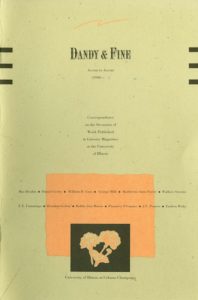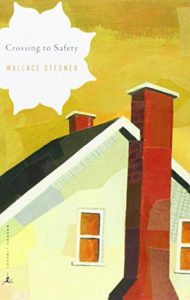As I posted last week, I often listen in as Beth listens to books. The latest of Beth’s audio books I’m eavesdropping on is by Wallace Stegner. Crossing to Safety was Stegner’s last novel. It received an extensive and positive review in the NY Times when published. But Stegner probably didn’t care so much by then. I know he didn’t care so much for the Times—he felt, and probably rightly—that the paper had not paid proper attention to his earlier work. The Times never reviewed his National Book Award winner (The Spectator Bird) and only acknowledged Angle of Repose after it won a Pulitzer.
I regret that it’s the first Stegner I’ve read, but I look forward to reading more. The writing’s superb for many reasons, one being that he chronicles nature in a sort of prose version of Ansel Adams. I’d tell you more but trust me, it’s more fun to Google him and go on a little virtual history expedition. There you may just bump into something serendipitously nice.
I know this because reading Stegner recalled a publication I worked on back in 1989 when I was an editor at the University of Illinois. I worked in a department that offered design and editorial services to other campus departments. We were engaged by the English Department to do the catalog for an exhibit called Dandy & fine: Accent to Ascent (1940- ): correspondence on the occasions of work published in literary magazines at the University of Illinois.
Whew, that academically stuffy title didn’t do it justice. The exhibit collected letters—handwritten and typed—from literary figures including Eudora Welty, Katharine Anne Porter, E.E. Cummings, Flannery O’Connor, and—as I recalled, Wallace Stegner.
These writers have all been published in one or the other of two literary magazines published at Illinois over the years. Back in 1989, the English Department had discovered and filtered through archives from those journals. I can tell you, those people could write a letter, and it was a privilege to literally get my hands on them and read them.

The cover of the exhibition catalog. If you care to look inside, click on the image, scroll down, then you can download two-views–but they take a long time.
I was the project manager on this one, and I worked with my favorite ever graphic designer, Julie, who is still a friend. Julie was the star of this show. This was before desktop publishing. Some of you may remember “mechanicals.” Designers would use real colored paper on one layer, type on another layer, another color paper on another—and each layer got shot on graphic film and then composited together. There weren’t no Illustrator or Photoshop or InDesign back then.
Anyway, thanks to Julie, the catalog for the exhibit ended up being a work of art in its own right, and lots of the people who pay attention to such things thought the same. It won multiple awards. It had a beautifully intimate look and feel, a very organic scrapbook of pieces and excerpts from the letters, accompanied by brief anecdotes about the editors of the journals over the years.
Too lazy to unbury my banker’s box of old publications I’ve hoarded, I made a couple Google queries and damn if I didn’t find the catalog online. Well, sort of. What I found are full scans of eight two page spreads. I could look at the whole publication two pages at a time. I was delighted to find that, in my view, it hasn’t aged, and Julie’s work remains as beautiful and appropriate to the subject as ever.
I was not as delighted to realize that it was Wallace Stevens, a great artist in his own right, and not Wallace Stegner who was one of the featured authors.
But I didn’t mind, really. It all took me back in time, and reminded me that some accidents are lucky ones.

Mike, thanks for bringing back this memory. I recall the catalogue – I think my copy is now in the archives – and the Rare Book Room exhibit that went along with it, where you could view
the letters themselves. And some of us might have accidentally wound up with a few stray
copies of Accent, which featured, in addition to those writers you mention, Bertold Brecht, Pablo Neruda, William Gass, and many others. Accent, by the way, was where Flannery O’Connor’s first published story appeared.
Thanks for all that, Jean. I remember being kind of awed by learning about all this. And there were all these other little treasures associated with the exhibit–I think there was either the actual manuscript for “From Here to Eternity,” or the screenplay, with markups about the racy parts.
Thanks for this post. I loved Angle of Repose, and can’t believe I now know someone who actually touched something that Flannery O’Connor touched! “There has been no previous publication.” What a treasure. She is one of my literary heroes.
Mike, Prof. George Hendrick was instrumental in obtaining the ms. of “From Here To Eternity”,
which was indeed edited to tone down explicit passages. In recent years he edited an edition of the original, unexpurgated ms. I believe it is available from the online publisher Open Roads.
I remember James Jones’ daughter, Cayley, I believe her name is, coming to campus on the occasion of the acquisition of the ms. Prof. Hendrick also wrote a book on the Handy Writers’
Colony in Marshall, Illinois, where James Jones stayed as a beginning writer. It was quite the
wild place in 50’s small town Illinois.
I remember Prof. Hendrick, he was a terrific guy to work with. And Bob Steltman, the grad student was, too. And thanks for the info about the ms.
Thanks for the link to this beautiful work by your friend. It must be a treat to go through the Rare Books Library at your Alma Mater. I can only imagine the memories conjured up by all this serendipity.
[…] « Mondays with Mike: Accidental goodness […]
Leave a Response